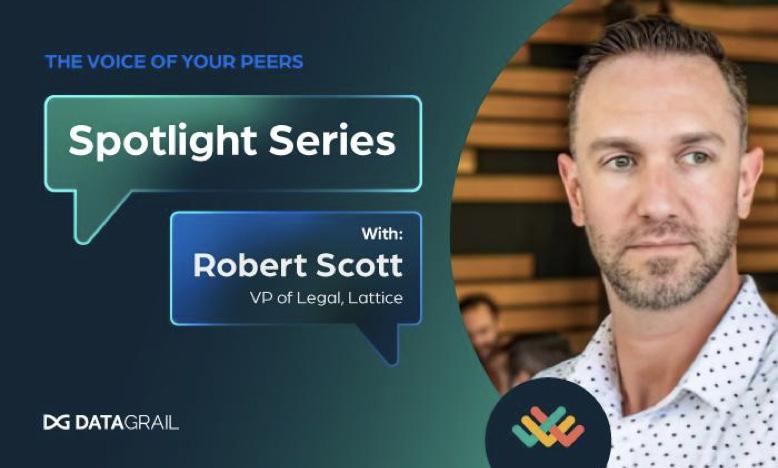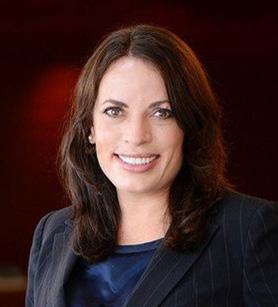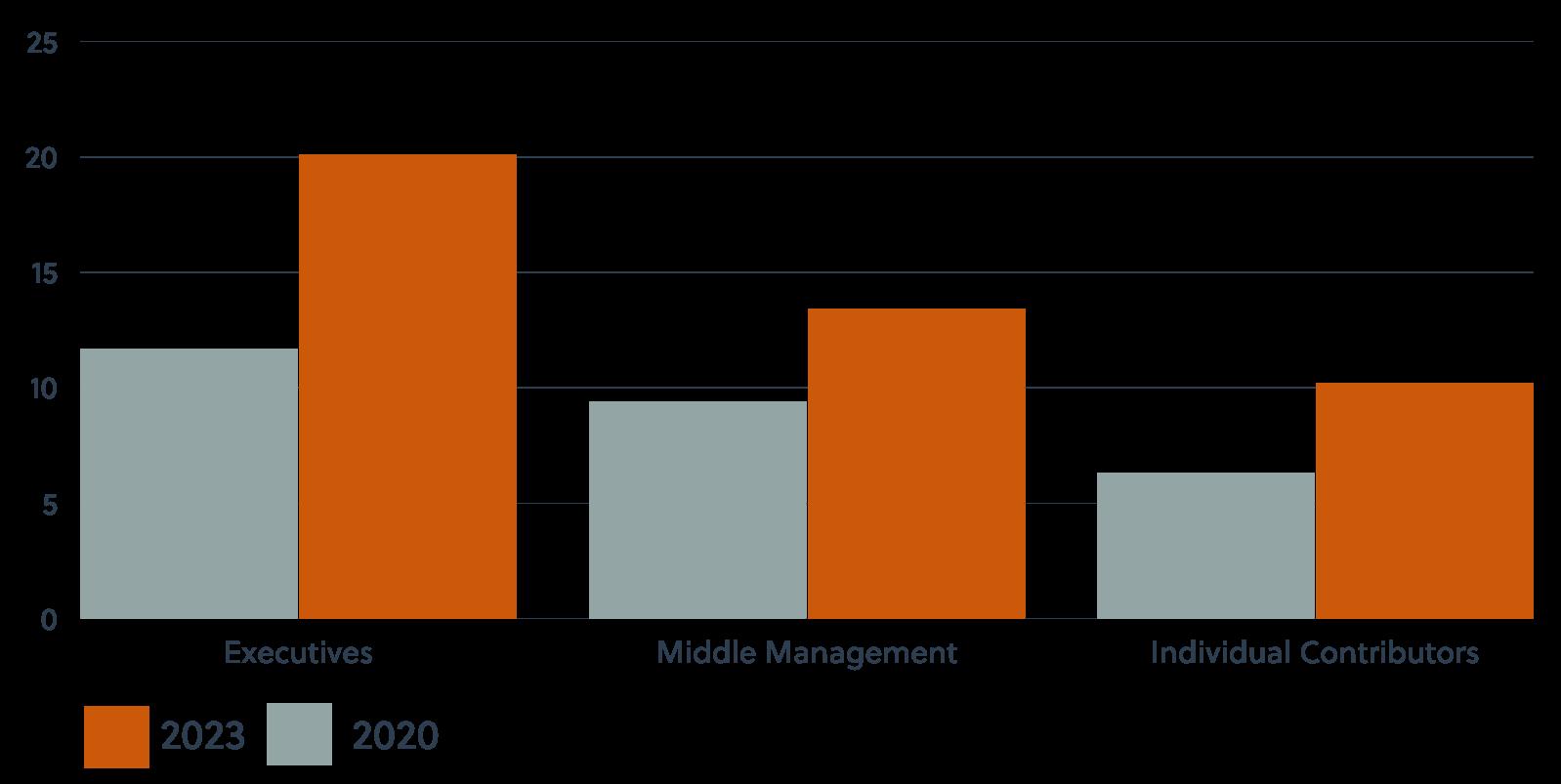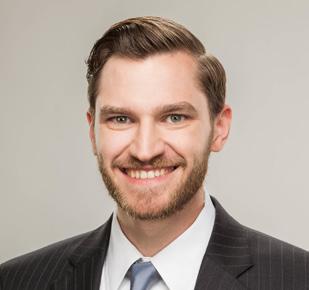NEW CRITERIA FOR DIRECTORS’ INDEPENDENCE
LOCKING IN THE COMMON INTEREST PRIVILEGE
INCORPORATING TECH-FOCUSED LEGAL STRATEGIES

DELAWARE LAW AND THE “ALTER EGO” THEORY
GETTING STAKEHOLDER BUY-IN TO YOUR PRIVACY PROGRAM
CRIMINAL INDICTMENTS UNDER SECTION 2 OF THE SHERMAN ACT
COMMUNICATING WITHOUT INFRINGING COPYRIGHTS
MITIGATING RISK WITH AI
$199 SUBSCRIPTION RATE PER YEAR
ISSN: 2326-5000
ISSUU.COM/TODAYSGC
MAY 2023 VOLUME 20/NUMBER 3 TODAYSGENERALCOUNSEL.COM










adr.org | +1.800.778.7879 ©2022 American Arbitration Association, Inc. All rights reserved. EXPERTISE Matters.
4 Editor’s Desk
INTERVIEWS
8 Interview with Eric Robinson of KLDiscovery
The role of AI and other emerging technologies in compliance and discovery.
14 Q&A with Robert Scott, VP of Legal, Lattice
Framing privacy as a benefit to stakeholders.
Interviewed by Alicia diVittorio, DataGrail
18 Interview with Katie Debord, Vice President, DISCO and Alex Guajardo, Pricing & Analytics Office, Shell USA Technology, partnerships, and “adjacent professionals”: the new paradigm for optimizing delivery of legal services.
COMPLIANCE
11 Questioning an Independent Director’s Independence Courts are looking beyond traditional criteria.
By Kenneth A. Rosen and Scott Cargill
16 Managing Risks of Veil Piercing Liability
The Delaware standards for disregarding corporate personhood.
By Mian R. Wang
COLUMN/THE ANTITRUST LITIGATOR
23 The Exchange of Information: Per Se or Rule of Reason?
Plausible pro-competitive justification is the likely test.
By Jeffery M. Cross
FEATURE S
26 The Paradox of Executive Behaviors in Content Sharing and Copyright
More information-sharing, less awareness.
By Julie Arrison-Bishop
28 The Common Interest Privilege May Not Be Common Knowledge
Some courts waive for clicking reply all, or forwarding a message to an employee.
 By Lionel Lavenue, Joseph Myles, and Dara Emami
By Lionel Lavenue, Joseph Myles, and Dara Emami
3 MAY 2023 TODAYSGENERALCOUNSEL.COM contents MAY 2023 Volume
3
20/Number
28
EDITOR’S DESK
Antitrust enforcement, which was notably absent under Trumpappointed heads of the DOJ, has stepped-up under Attorney General Merrick Garland. Jeffery Cross’s column in this issue of Today’s General Counsel examines a hot topic at the ABA Antitrust Section’s spring meeting: the possibility that the DOJ might pursue criminal cases under Section 2 of the Sherman Act which makes monopolization, attempt to monopolize, and conspiracy to monopolize illegal. Enforcement of Section 8 prohibitions against interlocking directorships has been vigorous in the past year as well. An article by Kenneth Rosen and Scott Cargill examines the broad question of director’s independence, and looks at two recent court cases. They suggest that general counsel scrutinize relationships between directors and the party responsible for their appointment.

Julie Arrison-Bishop’s article discusses a problem that shows up when executives ignore copyright policies and share content when they communicate with each other, and in an interview, Robert Scott, VP of Legal, Lattice, discusses how to build a successful privacy program. In another interview, Katie Debord and Alex Guajardo have a broad-ranging discussion about issues in legal operations. Lionel Lavenue, Joseph Myles, and Dara Emami write about privilege problems that arise when there is disclosure to a third party, especially in certain jurisdictions, and Mian R. Wang advises how to avoid losing the protection of corporate personhood in the Delaware courts, where the issue is normally adjudicated. It’s a high bar for plaintiffs, but not insurmountable, especially if the company simply functions as a façade for the dominant shareholder.
Bob Nienhouse, Editor-In-Chief bnienhouse@TodaysGC.com

4 TODAYSGENERALCOUNSEL.COM MAY 2023 BACK TO CONTENTS
Trials are not where you find new information. Trials are where you present evidence in a manner that is more persuasive and advantageous for your case. You design and ask questions to support your argument because you already have all the facts. Courtrooms are where you win cases, not build them.

With decades of experience, our subject matter experts and data strategists help businesses and legal teams tap into data – giving them control of the narrative for the best possible outcomes. This starts with an understanding of their needs and objectives through our STEPS™ framework – providing valuable insight into the unknown, the unseen, and the undiscovered. Having this insight gives them the opportunity to make informed decisions that lead to transformative outcomes.
At iDS, we work with our clients to find solutions to their data problems – helping to ensure that their data can be leveraged as an asset and not a liability.

CONSULTATIVE EXPERTS | STRUCTURED PROCEESS | CUSTOM SOLUTIONS /idiscoveryinc /idiscoveryinc /company/idsinc US: +1 800.813.4832 | UK/EEA: +44 (0)20 8242 4130 iDSinc.com
Don't ask questions you don't KNOW the answer to.
EXECUTIVE EDITOR
Bruce Rubenstein
EDITOR-IN-CHIEF
Robert Nienhouse
CONSULTING EDITOR
CHIEF OPERATING OFFICER
Stephen Lincoln
DIGITAL EDITOR
David Rubenstein EDITOR
Catherine Lindsey Nienhouse
CONTRIBUTING EDITORS AND WRITERS
Julie Arrison-Bishop
Scott Cargill
Jeffery M. Cross
Katie Debord
Alicia diVittorio
Dara Emami
Alex Guajardo
Lionel Lavenue
Joseph Myles
Eric Robinson
Kenneth A. Rosen
Robert Scott
Mian R. Wang
SUBSCRIPTION
rate per year: $199
For subscription requests, email subscriptions@todaysgc.com
SENIOR EDITOR
Barbara Camm FEATURES EDITOR
Jim Gill
MANAGING DIRECTOR OF CLIENT PARTNERSHIPS & INITIATIVES
Lainie Geary
DATABASE MANAGER
Jessica Bajorinas
ART DIRECTION & PHOTO ILLUSTRATION MPower Ideation, LLC
Dennis Block GREENBERG TRAURIG, LLP

Thomas Brunner WILEY REIN
Peter Bulmer JACKSON LEWIS
Mark A. Carter DINSMORE & SHOHL
James Christie BLAKE CASSELS & GRAYDON
Adam Cohen FTI CONSULTING
Jeffery Cross SMITH, GAMBRELL & RUSSELL, LLP
Thomas Frederick WINSTON & STRAWN
Jamie Gorelick WILMERHALE
Patricia McGuinness
EDITORIAL ADVISORY BOARD
Robert Haig KELLEY DRYE & WARREN
Robert Heim DECHERT
Joel Henning
JOEL HENNING & ASSOCIATES
Sheila Hollis DUANE MORRIS
David Katz WACHTELL, LIPTON, ROSEN & KATZ
Steven Kittrell MCGUIREWOODS
Nikiforos latrou WEIRFOULDS
Timothy Malloy MCANDREWS, HELD & MALLOY
Steven Molo MOLOLAMKEN
REPRINTS
Thurston Moore
HUNTON & WILLIAMS
Robert Profusek
JONES DAY
Art Rosenbloom
CHARLES RIVER ASSOCIATES
George Ruttinger CROWELL & MORING
Jonathan S. Sack MORVILLO, ABRAMOWITZ, GRAND, IASON & ANELLO, P.C.
Victor Schwartz SHOOK, HARDY & BACON
Jonathan Schiller BOIES, SCHILLER & FLEXNER
Robert Zahler
PILLSBURY WINTHROP SHAW PITTMAN
For reprint requests, email Lisa Payne: lpayne@mossbergco.com Mossberg & Company Inc.
All rights reserved. No part of this publication may be reproduced or transmitted in any form or by any means, electronic or mechanical, including photocopy, recording, or any information or retrieval system, without the written permission of the publisher. Articles published in Today’s General Counsel are not to be construed as legal or professional advice, nor unless otherwise stated are they necessarily the views of a writer’s firm or its clients.
Today’s General Counsel (ISSN 2326-5000) is published ten times per year by Nienhouse Group Inc., 110 N. Wacker Drive, Suite 2500, Chicago, Illinois 60606. Image source: iStockphoto | Copyright © 2023 Nienhouse Group Inc. Email submissions to editor@todaysgc.com or go to our website www.todaysgeneralcounsel.com for more information.

Subscription
Answers in minutes, not months with Document Intelligence
Empower your in-house team to reduce external spend on document review and provide accurate guidance sooner. With Thomson Reuters Document Intelligence, gain immediate insights into contracts with AI pretrained by Practical Law attorney editors.
50% faster information retrieval and review
<1 minute to pinpoint critical provisions across thousands of documents
3 clicks to discover risks and revenue optimizations
Mitigate risk, seize opportunities, increase productivity, and identify savings.
? ? ?
Scan QR code to learn more about Thomson Reuters Document Intelligence.
Interview with Eric Robinson of KLDiscovery
How does AI play a role in establishing efficiencies for data mining in cyber incident response over traditional models?
For almost a decade, the incident response industry has relied on traditional eDiscovery tools to conduct data mining. However, this approach has not been entirely effective, as traditional eDiscovery tools have not been designed with data mining in mind. Data mining is a distinct process that requires a different mindset and approach.
In most scenarios, impacted data sources are extracted from their native environment for data mining analysis, in order to allow the enterprise to get back to business as usual. Extracting the data allows for data analysis and mining leveraging advanced tools and technologies, not readily available in the native environment.
By leveraging better analytics tools in the initial stages of the data mining process, you can create significant efficiencies. Cyber incidents are stressful, expensive, and traumatic for end-clients (and insurers), so finding ways to make the process more effective and efficient is crucial. Artificial intelligence (AI) and AI-related technologies have proven useful in this regard, enabling the industry to deliver better solutions, usually within shorter timeframes and at lower costs than traditional technologies.
How would you describe AI and AI-adjacent technologies from a compliance perspective? And what role do these types of technologies play in an environment of heightened security and changing rules around regulatory compliance?
The current state of the world is marked by the exponential growth of data. Recent studies show that the volume of data being retained, stored, and created annually is doubling. This trend continues to grow due to new data sources, modes of communication, and
Eric M. Robinson, JD/PMP Vice President, Global Advisory Services & Strategic Client Solutions
 Eric.Robinson@KLDiscovery.com
Eric.Robinson@KLDiscovery.com
the increasing need for data intelligence. The availability of data requires alternative means of data analysis, especially for compliance and investigation purposes. Recent headlines have shown that regulators, both in the US and globally, are monitoring organizations more closely in terms of data management, creation, and retention. This monitoring forces organizations to create compliance regimes to manage and maintain data.
Regulated industries have specific requirements they must comply with and there are heightened security concerns due to cyber risks associated with their data. Organizations need to understand the data they have, where it is, and what is in it to identify sensitive or protected data. There is also a shifting landscape of regulatory regimes globally. To keep up with these changes, organizations must leverage technology, automation, and artificial intelligence to help them understand what they have, where they have it, and even alert them when data or communication contains sensitive or inappropriate types of information.
How are these technologies important for regulated industries?
Using the financial services sector as an example, compliance and surveillance programs are critical and required. The challenges posed by today’s data and technology landscape makes it nearly impossible to achieve these requirements without some form of AI or AI-adjacent technology.
Large financial institutions such as private equity and venture capital firms retain billions of messages in
8 TODAYSGENERALCOUNSEL.COM MAY 2023 BACK TO CONTENTS
INTERVIEW
Experienced Cyber Incident Response
Cybersecurity incidents are now so prevalent that the question has moved from not if, but when to how many times. Given the pervasiveness, you need a dedicated Cyber Incident Response team on your side to provide:

� Industry insight and actionable steps to take to limit your risk prior to an incident
� The latest strategies for data mining post-incident, including reducing the time and cost to analyze impacted data for PII/PHI
� Post-incident insight to refine your internal data management practices
Learn more about KLDiscovery’s specialized Cyber Incident Response team and how their expertise, purpose-built technology solutions, and tailored workflows can help you with readiness and response.
www.kldiscovery.com/who-we-serve/cyber-incident-response
Get
Expert Help
their archives, making basic keyword searches inefficient by potentially taking days, weeks, or even months to complete. AI technology is able to scan through these volumes of data and identify potentially illegal and/or inappropriate communications. Standard technology would have a much more difficult (if at all) time identifying this type of behavior.
The shifting regulatory landscape regarding communications has resulted in multimillion-dollar fines to several large financial institutions and related enterprises. As such, organizations are being pressed to be more proactive in ensuring appropriate compliance and surveillance programs. These programs can and should leverage technology enabling them to scan an environment and identify specific emails or text messages that contain critical information that raises a flag. In industries subject to heightened regulations, it is vital to have technology that can monitor data sources efficiently. Without AI or AI-adjacent technologies, regulatory requirements may not be met.
So how can AI and AI-adjacent technologies impact discovery or investigations? And what are the downstream benefits of leveraging these technologies?
In today’s world, leveraging technology can help organizations gain insight into data, making their downstream processes more efficient and effective. By using enterprise-level systems, companies can flag broker trader issues or SEC compliance audits and identify any potential malfeasance. This not only helps in the downstream process of catching issues and taking remedial action, but it also raises awareness, allowing companies to go to regulators and demonstrate their compliance efforts.
Regulators are now promoting a self-reporting mechanism, and identifying issues early on in the process narrows the scope and makes manual reviews more manageable. However, even if enterprise-level systems cannot identify issues, AI and AI-adjacent technologies can help discover and investigate relevant data. By using predictive coding and predictive analysis, organizations can find similar contextual documents within the dataset.
The approach an organization takes toward managing data depends on various factors. Some organizations have in-house teams with expertise in managing data, while others may risk malpractice if they provide legal advice without relevant experience. For organizations with in-house teams, early data analysis can provide
valuable insights and help narrow the scope of data before it is provided to outside counsel. This can ultimately reduce the workload and costs for outside counsel.
But managing the data discovery process requires coordination between the end client, outside counsel, and the discovery provider. The discovery process is like a funnel meant to narrow down the scope of data as much as possible. Leveraging AI and AI-adjacent technology can significantly aid in achieving this goal.
With the recent focus on AI in the media, including ChatGPT and the Metaverse, where do you see potential impacts on discovery and compliance?
I think the reality is that we will continue to see an evolution in available technologies, including platforms like ChatGPT and Metaverse, and these will be sources of discoverable data which no one has a solution for yet. There is a forensic challenge as well that, again, we do not have an answer to yet.
Take the Metaverse. You are talking about a platform in which, for lack of a better way to put it, you have individuals role-playing in real-time in a created environment. When organizations start having meetings in the Metaverse as opposed to Microsoft Teams, Zoom, or another similar platform, what type of audit trails, metadata, and tracking is available?
At this point, we do not have answers, but these types of questions are being asked. These newer platforms have not yet been brought into litigation, meaning they have not been tested yet. I think we are going to quickly be struggling to figure out how to answer these questions.
Yes, exactly. It is like any nascent technology where we can see this is going to generate discoverable data, but until someone requests it for litigation, no one is going to create a solution. But I agree that the chatbots and Metaverse are a whole new beast. They most definitely are.
10 TODAYSGENERALCOUNSEL.COM MAY 2023 BACK TO CONTENTS
COMPLIANCE
Questioning an Independent Director’s Independence
By KENNETH A. ROSEN AND SCOTT CARGILL
Historically, when courts reviewed the independence of a company’s outside directors they have focused upon the business relationships and economic links between the director and the company for which the director will serve as a board member. Increasingly, however, courts are also scrutinizing the relationships between an independent director and the person who nominated the director, to better evaluate the

director’s independence. These developments concerning how a director’s independence from a company is appropriately evaluated highlight the need for general counsel to conduct appropriate due diligence prior to accepting the nomination of a proposed independent director.
Traditional objective criteria for determining a director’s independence, such as whether the director is employed by the company; is related
to an insider; holds equity interests in the company; conducts business with the company, are easily quantifiable. However, recently more subjective and less visible relationships, such as the identity and relationships of the parties responsible for appointing the independent director, have increasingly been used as a basis to challenge a director’s independence. Gaining or losing a directorship can have a big financial impact on an individual director. In some instance,
MAY 2023 TODAYSGENERALCOUNSEL.COM BACK TO CONTENTS 11


a person’s overt desire to establish, maintain, or strengthen a relationship with the nominating party can support an inference that the director is not truly independent.
Professors Jared Ellias, Ehud Kamar and Kobi Kastiel recently published a controversial article entitled The Rise of Bankruptcy Directors (Southern California Law Review, Vol. 95, No. 5, 2022). The article examines an independent director’s allegiance to the party that
effective and less disruptive manner.
Elias, Kamar and Kastiel further argue that certain directors suffer from a structural bias because they are “repeaters” - directors regularly nominated by private-equity sponsors and law firms. The article suggests that obtaining future directorship appointments may require not upsetting the source of the director’s appointment.
An example is the case of shoe retailer Nine West Holdings, Inc. In
past relationship with a venture capital fund may have compromised the directors’ independence. The court cited the article by Elias, Kamar and Kastiel and found the directors were repeat players in the biopharma and healthcare sector. Because the venture capital fund was an activist, which creates opportunities to put candidates on boards, it could reward directors nominees that are aligned with the fund’s interests.
appointed the director to corporate boards in chapter 11 bankruptcy cases. The article concluded that an ostensibly independent director might nonetheless be indebted to the party responsible for their appointment, which could result in a lesser recovery for creditors in chapter 11 cases. Specifically, the article hypothesizes that some independent directors may refrain from being as diligent or critical as they should be in evaluating or investigating company transactions that involve insiders and/or related parties.
The professors submitted that there is an increased need today to focus on the “true” independence of such board members. One reason is that chapter 11 debtors increasingly assert that a court should not permit creditors to conduct costly investigations of company transactions during the course of the bankruptcy case because a committee of independent directors will satisfy such oversight role in a more cost
August 2017, the company needed to commence a Chapter 11 bankruptcy case and hoped to emerge promptly from court protection. But, there was danger of creditor litigation alleging that the company’s controlling shareholder had plundered the company. Because the board had a conflict of interest, the board appointed two bankruptcy experts to the board who claimed that, because they had no prior ties to the company or its equity sponsor, they were independent and could handle the investigation. The bankruptcy court allowed the new directors to take control of the litigation and ultimately settle the claims. A creditors’ trust subsequently sued the board alleging that certain directors were closely aligned with the equity sponsor and therefore lacked sufficient independence (Nine West LBO Securities Litigation S.D.N.Y. 2020).
Most recently, in a nonbankruptcy case, Goldstein v. Denner, the Court of Chancery of Delaware found that two directors’ current and
What is the takeaway? The general counsel should closely scrutinize the relationships between the independent director and the party responsible for their appointment — especially when relying on an independent committee of the board to investigate transactions where the insider board members have a conflict.
Kenneth A. Rosen is a partner and Chair Emeritus in the Bankruptcy & Restructuring Department of Lowenstein Sandler LLP. krosen@lowenstein.com

MAY 2023 TODAYSGENERALCOUNSEL.COM BACK TO CONTENTS 13
These developments highlight the need for general counsel to conduct appropriate due diligence prior to accepting the nomination of a proposed independent director.
Q&A with Robert Scott, VP of Legal, Lattice
 Interviewed by ALICIA DIVITTORIO, DATAGRAIL
Interviewed by ALICIA DIVITTORIO, DATAGRAIL
Our interview with Robert focuses on how he successfully evangelizes and scales privacy to ensure cross-functional alignment. Robert takes us through how he frames privacy as a benefit to each of his stakeholders, and how a European expansion proved the value of a privacy-first approach.
Who must you get input from to build a successful privacy program?
There are two core stakeholder groups that need to buy into privacy: Leaders across all core functions at the business (marketing, engineering, product, and finance), and individual contributors across all departments who can identify risk. Let me explain.
Like any program that impacts multiple departments, executive team support is critical. Leadership helps champion the program, so the entire organization sees privacy as an organizational value, taking privacy out of the “checkbox” mindset, turning it into a value the entire organization can support.
14 TODAYSGENERALCOUNSEL.COM MAY 2023 BACK TO CONTENTS
INTERVIEW
With privacy, identifying risk early on is crucial, and we’ve found that individual contributors in product development, for example — and other parts of the organization are our eyes and ears. If they’ve been trained well on how to identify it and flag issues, they help identify risk early on.
Talk to us about the different stakeholders. How do you get security excited about privacy? The compliance, marketing, and product/engineering teams?
To get any stakeholder excited, talk to them and understand their motivation in their work. Understand how to be a good partner to them and align with their goals. Security is the group with which we interface most, and thankfully they are pro-privacy. They are happy to have an in-house legal staff that wants to do legal work, so they can focus on security. Together with security we emphasize data hygiene, and reducing risk with things like data minimization. Security, legal, and compliance have parallel goals as it relates to privacy, and we can pull on the compliance lever if we need to.
With our friends in marketing we talk about how good data integrity and data minimization can lead to increased efficiencies and better data to build campaigns. We also actively lean into privacy being a brand differentiator.
Product puts a massive emphasis on product trust so we talk about how privacy is a trust driver with them. Privacy is a trend we want to be ahead of, and we’re facilitating our customer trust in product and brand for the long term.
Our engineering and analytics teams like hard data; it has to be black and white. Facts. Resourcing can be a constraint, but we always try to make it a partnership rather than an us vs. them issue.
How do you measure or convey the ROI of a robust privacy program?
We know the cost of fulfilling a data subject request manually — before DataGrail — and after. It went from approximately 15-20 emails down to two emails. A huge drop down. We also talk a lot about brand value, and how privacy builds up our brand loyalty and in the end builds our business.
We’ve seen that intelligence from our privacy program can be used in other parts of our business. For example, we’re actively using the insights learned from
the data mapping process to build out a more mature procurement process. We now understand our data processing universe much better, and therefore can identify inefficiencies and redundancies. Visibility into data mapping helps us in negotiations, helping limit the data processing a new vendor might attempt.
What are the biggest obstacles you face when trying to secure budget or resources, and how do you overcome them?
The work is never done when building a privacy program, which means my team and I are regularly asking for more to build. I am constantly asking the question, “what’s the right amount of resource investment that is best for our business?” As a customer-centric business, that question can be reframed as “what’s the right amount of resource investment that is best for our customers?” If I can answer that question, I can gain the support of any stakeholder anywhere in the company.
Occasionally I’ll look outwards at what our technology peers are doing, and use that as a lever to drive initiatives forward. Our expansion into Europe really helped the need for a robust data privacy program. The increased ability to sell into the EU as our security and privacy posture matured over time continues to support expanding our privacy program. We’ve built a brand around security and privacy, and we’re seeing how that ultimately pays off from a financial perspective.
In the end, trust-building across leadership pays dividends in the long run and is how you’ll eventually overcome obstacles that may come your way.
MAY 2023 TODAYSGENERALCOUNSEL.COM BACK TO CONTENTS 15
Managing Risks of Veil Piercing Liability
 By MIAN R. WANG
By MIAN R. WANG
Legal personhood of corporate entities is a fundamental tenet of doing business. Legal personhood is also critical to allowing businesses and investors to manage risks. However, corporate families may not have the protection of their “corporate veil” and expose themselves to “veil-piercing” claims when the corporate form is abused. Because many corporations, limited partnerships, and limited liability companies are organized under
Delaware law, this article provides a general overview of the standard of veil piercing under an “alter ego” theory under Delaware law where the corporate form is sought to be disregarded. In addition, it provides some practical steps that can be implemented to manage the risk of a veil piercing claim.
As a starting point, Delaware courts by default will respect the corporate form, and persuading a Delaware court to disregard
the corporate entity is a high bar. Circumstances under which a Delaware court has allowed a veil piercing claim to proceed past a motion to dismiss tend to be cases where substantial and detailed factual allegations reflect that there was fraud, public wrong, contravention of law or contract, or where equitable consideration requires it.
Delaware courts consider a number of factors in determining whether to disregard the corporate
16 TODAYSGENERALCOUNSEL.COM MAY 2023 BACK TO CONTENTS
COMPLIANCE
form and pierce the corporate veil, including whether the company was adequately capitalized; whether the company was solvent; whether corporate formalities were observed; whether the dominant shareholder siphoned company funds; whether, in general the company simply functioned as a façade for the dominant shareholder. While no single factor is determinative, some combination of these factors is required. In addition, Delaware requires that the corporate structure causes an overall element of injustice or unfairness.
in a subsidiary’s or an affiliate’s operations. Courts examine the level of hands-on and day-to-day control. Even if the same people were involved, related companies may still operate independently by focusing on different markets, products, or services.
• Adequately capitalize a subsidiary or an affiliate, particularly at formation, and maintain its solvency.
• Maintain corporate formalities, such as separate email addresses, letterhead, names, employees, locations, bank accounts, logos, and books and records.

• To the extent that there are intercompany transactions, which are not improper in and of themselves, ensure proper accounting of all funds and proper documentation of such transactions.
Thursday, May 18 1pm ET / 12pm CT
In the last few years, Delaware cases that involved a veil piercing claim reflect the standard to pierce corporate veil remains high. Those cases that survived a motion to dismiss contained allegations that were highly fact specific and demonstrated that the corporate form was used to commit fraud, and in particular, to avoid a financial liability.
While the bar to plead a pierce the corporate veil claim is high, and the ultimate burden of establishing liability is highly fact specific, businesses can implement several ways to preserve corporate separateness.
• Minimize overlapping high-level personnel managing, operating, and controlling a subsidiary’s or affiliate’s day-to-day operations.
This does not necessarily mean a parent cannot set general policies or standards of operation or must avoid any involvement
• Changes in corporate structure or form, meetings and minutes, and votes should be documented.
Veil piercing is a highly factintensive claim and requires an element of fraud or injustice under Delaware law. No single factor alone is likely to justify veil piercing. A company can better manage its risk of a veil piercing liability by implementing standards and practices that provide evidence of its independence from a parent company or dominant shareholder.
Mian R. Wang is a shareholder in Greenberg Traurig’s Boston office. She focuses her practice on high-stakes business litigation, and represents public and private companies, financial institutions, directors, officers, and individuals in complex commercial litigation and bankruptcy litigation.

In this webinar, we will discuss: the role of CLM in revenue management; how to uncover the hidden benefits; and how to set up your team for success.
Register Now
Sponsored by
MAY 2023 TODAYSGENERALCOUNSEL.COM BACK TO CONTENTS 17
More Webinars Webinars *Free CLE available for many webinars in several states. See registration page for details. CLE not available for on-demand viewing.
Webinar
Delaware requires that the corporate structure causes an overall element of injustice or unfairness.
View
Free
UPCOMING How to Understand the Value of your CLM Technology
Interview with Katie Debord, Vice President, DISCO and Alex Guajardo, Pricing & Analytics Office, Shell USA
Today’s General Counsel recently spoke with Katie Debord, Vice President of DISCO, and Alex Guajardo, who recently served as Pricing & Analytics Officer at Shell USA, and has now joined BCLP as its Global Director of Commercial Strategy.
This interview focused on the direction of work in the legal industry, macroeconomic conditions, transformation in law firms and corporate legal departments, and the impact of tech innovation and tech strategies.

Could you describe your background and tell us what led you to pursue a career in the legal industry?
Katie Debord Vice President, DISCO
Katie is a proven leader in scaling legal practice transformation, and partners closely with customers to further establish DISCO as a crucial partner and platform of choice for legal teams that are embracing technology to achieve better legal outcomes. Prior to DISCO, Katie was the global chief innovation officer at Bryan Cave Leighton Paisner, where she led the firm’s international cross-disciplinary team dedicated to the innovation and optimization of legal services. She is a popular speaker about legal innovation at industry conferences, educational venues, podcasts, and thought leadership events.
Alex is an industry expert in Legal Operations with over 20 years of experience on both the firm and corporate side. She is currently responsible for the management and advancement of the Outside Counsel Program at Shell USA, while providing support to all legal departments globally. Her extensive experience in Legal Operations allows her to apply a strategic mindset to the operations of the team, business processes, pricing negotiations and day-to-day activities to ensure effective and streamlined support is consistently delivered. She is an active speaker in the Legal Operations community and Co-chair of LVN’s annual conference.
Katie Debord: I started my professional career at the CIA as an intelligence analyst, and I became very interested in the law, the rule of law, and how rules are created to define conduct and make things more predictable from both a civil and human rights perspective. I went to law school, got a summer associate position with Kirkland and Ellis, and figured out that I loved litigation. So I became a litigator, and that’s really how I entered the practice of law.
Alex Guajardo: I am not a lawyer. My first exposure to legal work was on a field trip when I was in the honors society, and we toured a law firm. I thought it was amazing and decided that working in the legal field was something I wanted to pursue. My first job was at Fulbright and Jaworski, where I started as a conflicts analyst doing conflicts checks. I worked in finance, moved into their IT department, and then went into practice management. After that, I landed in legal operations roles based on the work that I was doing. But it all started with a very innocent field trip to that law office.
What impact has tech innovation had on the legal sector in the past few years?
Katie Debord: There is an old adage that lawyers hate

18 TODAYSGENERALCOUNSEL.COM MAY 2023 BACK TO CONTENTS
INTERVIEW
Alex Guajardo Pricing & Analytics Office, Shell USA
technology, but I don’t think that’s true anymore. Lawyers are using consumer technology and understand and appreciate the benefits of technology in their lives. And those lawyers who have positive experiences with technology in their practice understand that tech-enabled solutions enable them to do things better, faster, and cheaper. You’ve got to find a way to be efficient. You’ve got to find a way to do things so that there is more quality control. I do think that innovation has changed the mindset of practitioners with regard to technology.
Alex Guajardo: We have seen so many new developments in legal technology, yet until recently, people were afraid to move into the tech realm because of concerns about confidentiality and data privacy. There are more safety protocols being put in place to ensure that our cybersecurity space is protected. Technology makes sense in many areas. It makes us more efficient, it makes us better at what we do, and it puts the right data in front of us. Technology innovation has really showcased how we can optimize productivity.
Katie Debord: I think we’re already there. What I see is more adjacent professionals — project managers and process engineers — working with lawyers to deliver legal services to clients. They can optimize the way that legal advice and legal services are being delivered and, on the enterprise side, the way that the clients are ingesting and operationalizing the legal advice. We are also going to need other types of adjacent professionals such as technologists and data analysts. The old-school way was that a lawyer and a client were the only two parties involved in legal service. Increasingly, that is going to become a thing of the past.
Alex Guajardo: I would add that many of our laws and regulations have gotten more complex over time. The need to involve more people based on subject matter, jurisdictional challenges, and new regulations requires everyone to be more strategic on how we approach anything in front of us. We are doing more with less, and what we need to focus on for both the law firm and corporate legal department is to make sure that the right people are doing the right things, and that people are focused on things that only they can do. That is why we are working together — internal lawyers in the legal
department and Legal Ops with its technology and vendors. These different pieces are intricately connected, and they’re all necessary because we each bring something different to the table. Efficient collaboration is going to make things move in the best way possible.
How will macroeconomic conditions affect the industry in the near and long term?
Katie Debord: There are some areas of representation and some types of representation where the cost doesn’t matter. You just need to get it done right. But for everyday operational legal advice, there is continuous pressure to do things better, faster, cheaper. I think that is very true on the enterprise side of the equation, and it’s mostly true on the law firm side. I don’t necessarily think, from the macroeconomic perspective, the environment is going to change that pressure.
We are also seeing a lot of pressure on the law firm side to secure lateral partners. A firm needs to demonstrate to prospective laterals that it is innovative and that it can give its lawyers the tools needed to do the best job they can for their clients. Lateral partners that I talk to increasingly ask questions about whether the law firm can enable them to meet their client’s needs with a technological, process-driven approach. I think that will continue. We are also seeing combination activity again in 2023. As law firms get bigger and, as Alex was saying, the delivery of law becomes more and more complex. I think law firms, for the most part, are starting to figure out ways that they can address that complexity through mergers and acquisitions.
Alex Guajardo: There’s always going to be a need for extra legal support. Our company, for example, is always going to have cases that need external counsel support, and when we think of it that way, our decisions depend on what we’re trying to accomplish because we can’t do it all, and we don’t expect any of our law firms to do it all. Often, we just have to take a step back and say, “What do we need for this case and who do we need?”
As much as corporations have to understand the external law firms that support us, it’s important for law firms to know their own identity, what they can provide, and what sets them apart. And, on the corporate side, we have to know not only what we need but also what we can deliver. This all affects the relationship that law firms and clients have with each other, and there are going to be continued pressures.
MAY 2023 TODAYSGENERALCOUNSEL.COM BACK TO CONTENTS 19
Innovation has changed the mindset of practitioners with regard to technology.
Katie Debord: Well, Alex, are there conversations about doing more insourcing of work on your end? Or is it the opposite, more outsourcing of work?
Alex Guajardo: Something that has resulted from the pandemic is that people have realized that they want work-life balance. Yet at the end of the day, there is still the pressure to deliver. In terms of whether on our end we will be doing more insourcing or outsourcing of work, there are certain cases that are high risk and high exposure that always tend to require a certain level of expertise. Communicating to our firms — what does success look like for this case, and what are we trying to accomplish — is imperative. Sometimes there are things that we have to handle in-house and there are other things that require a different path. There is no cookie-cutter approach for legal support.
How has transformation impacted the firm’s ability to drive profitability, productivity, and client retention?
Katie Debord: There are a couple of elements to this. One is price predictability, which is good for both the law firm and the client. The client pays what they expected to pay, and the law firm doesn’t have write-offs. Certainly, innovation and technology enable and support price predictability in several different ways. And nesting in faster ways of doing things enables you to go to a flat fee because you’re using automation tools. When you have predictability, you have profitability.
The second element is what Alex has been talking about, the complexity of getting things done. The more that you can put the pieces together for your client, help them operationalize the advice you’re giving them, and think through the best processes, the best practices, and the best staffing to manage different matters or streams of matters, the closer you get to your client. The more you address a client’s business needs, and are not just thinking of them in terms of a one-off legal matter, the more they will want to work with you in the future. All of it is really intertwined.
Alex Guajardo: Law firms have been transforming by adapting to what the clients are asking for. The corporate legal side is also transforming, looking at how we can do things differently. It’s not just about the price. It’s about communicating what expectations are and what the firm can deliver. Transformation only happens if the firm and the corporate side are willing to listen to each other. We have to be willing to come to the table and have discussions about what the case looks like, what
we’re trying to accomplish, what the vision is for this year, and what challenges are coming up.
At the end of the day, law firms want to make money and corporate clients want to get the right outcomes at the right price and capture the right value. For a long time, there was a misconception that clients just wanted the cheapest and best, and that is not true. What we’re realizing is that everyone needs to be on the same page concerning what budgets are actually paying for, what we get in return, and what services we should expect to see delivered. Transformation only happens if there’s a truly collaborative effort on both sides.
How do you measure that? and how often? Even though your company and the firm are on the same page, how do you know if you are getting what you are looking for? What process do you use to obtain the results?
Alex Guajardo: We have a very elaborate RFP process, and we have Alternative Fee Proposals (AFA) requirements around matters and casework. We also are required to put information in front of our lawyers so that they can ask the right questions. Our attorneys take more of a business approach to a case, that is, alignment rather than just negotiation.
What we look at is what are our actuals against our budgets, and what the intended purpose was. We know that not everything works in the way we intended and that deviation is sometimes necessary. When we deviate, how do we deal with that? At the end of the day, the biggest measurement is whether we get to the intended outcome. If so, what was the result? After-action reviews are necessary so we learn from those results. Sometimes we have unrealistic expectations on our side and need to communicate to the other side: “That isn’t something that’s within the boundaries or the criteria that you’re giving me.” Without communication, that intended outcome doesn’t happen.
Katie Debord: I think this is where project managers can be helpful because they are trained to define the intermittent measures of success. What does success look like at various stages? Are we having a level-set conversation or are we doing what we said we wanted to do? Have things changed? And if so, are we addressing that change? This is an example of that adjacent expertise that I think is becoming important — to make sure the lawyer and the client stay on the same page concerning what’s happening and what needs to be done.
20 TODAYSGENERALCOUNSEL.COM MAY 2023 BACK TO CONTENTS
How does what’s happening with transformation differ from a couple of years ago?
Alex Guajardo: We are in a different mindset than we were a couple of years ago and are applying the terms “pre-pandemic” and “post-pandemic.” Everything is no longer a crisis or an emergency, and now we can see that the pandemic has allowed us to prioritize things a little more realistically. Pre-pandemic, we were just trying to put out fires and didn’t take time to slow down. Now, we are being more flexible and understand that not everything requires an immediate response, giving us more time to prepare. That is where I’ve seen the biggest change. I think we’re all more willing and open to giving things additional time if it is necessary.
Katie Debord: I had been working with an international team for years before the pandemic so I was familiar with communication platforms, but many people were just starting to use Zoom for the first time. And everybody saw the hilarious video of that poor lawyer who was on a video conference with a judge, and the lawyer’s face appeared as a cat. It allowed us to be more forgiving of ourselves and understand we just had to get up to speed with technology. And ultimately, I think it gave people more confidence in using technology and adding it to their basic skill set. Again, as Alex said, we are being more flexible and recognizing that in some ways we’re all learning together.
Alex Guajardo: We have been more adaptive and adoptive of new technology. One example is how our company finally implemented electronic signatures, which we had been trying to do for years but only on an on-and-off basis. Now, because people are working remotely and can’t get their printers to work at home, it’s the norm for us. It seems like something so simple that we should have been using it for a long time, but people weren’t comfortable with the idea. When we couldn’t scan and transmit, or drive to someone’s house because of the pandemic, electronic signatures became a necessity. It made us more adaptive to new technology. Now, when technology comes along, the instantaneous response is not “Wait a minute, do I need this?” Instead, it is “How can this help me?”
What are some steps (both small and large) that organizations can take to bring innovation and tech-focused strategies into the practice of law?
Alex Guajardo: We’ve been doing the same things for a long time with some of the same processes. But after
we’ve implemented them and they seem to be working fine, there can still be breakdowns. Even if a process is working well, it’s important to ask, “What modifications do I need to make?” If we don’t do that on a continuous basis, we will never improve because change happens continuously. Technology can do everything under the sun, but if you do not have a process around the technology, it will fail. Then people lose confidence in the technology, the data that the technology provides, or the process that it’s supposed to help. We have to take a step back and be ready to assess and ask, “Am I doing the right things in the right place?” Only if the process is in place can you implement the technology to go along with it. I am 100% convinced that process improvement is always going to be critical.
Katie Debord: I’d say 1,000%. There are so many companies I’ve spoken with that want to implement a contract management system, but they have not done the work to understand their current processes or optimize them for the technology. Just slapping technology on a bad process is a recipe for disaster. So absolutely, process improvement has to be the first step. The next step is evaluating what can facilitate that process, for example, an automation tool. The e-signature tool is a perfect example. Where can we eliminate humans entirely? How could we automate term sheets with pre-approved terms by the general counsel’s office so that the business knows what agreements they can enter into without having to go through legal? All of that becomes part of the conversation once you’ve figured the process out.
Would you say that change management and training are important components of process improvement?
Alex Guajardo: When we’re having any issues or challenges, we look at the process, the training, the documentation, and the people. I think the first reaction is that the employee must not know what they’re doing, but it’s not always the employee’s fault. Sometimes the process was not in place. Sometimes neither the documentation nor the training provided enough information for the employee. Both training and documentation are extremely important.
MAY 2023 TODAYSGENERALCOUNSEL.COM BACK TO CONTENTS 21
Transformation only happens if there is true collaboration on both sides.
Sometimes, too, we overcomplicate things. For example, the instructions may be too complex and may be based on the knowledge of someone who has been performing a job for so long that it is second nature. Someone completely inexperienced with the process should be asked what it looks like to them. What they have questions about will be completely different from someone with years of experience, who may not realize the need for in-between steps. And these steps are very important.
Katie Debord: I completely agree, and I think from at least a law firm perspective, it will be the case that an organization will bring in technology and expect users to use it just with basic training. The users don’t feel like the trainers understand their practices or what they need out of the technology. And the trainer doesn’t have enough information to provide that kind of context to the user. The more that people who are engaged in change management really understand how the users will be using that technology for their specific use case and how that technology can help them, the chances of adoption become far greater. It’s important to think not just about setting up training, but who is training, what they understand about the end user’s objectives, and how they’ll be using the technology.
Alex Guajardo: You can’t assume that people are ready to use the new process or technology just because they have had basic training and documentation. After
Are there any closing remarks you want to make?
Alex Guajardo: The keys to a good partnership on both sides are transparency and ongoing communication. We can’t make assumptions that other people know what we are thinking. On either side, we have to be vocal, open, and transparent about what we need and what we want. If we want our partnerships to thrive, we need to communicate what our expectations are and make sure that difficult conversations take place in a helpful and professional context. We need to remember that the discussions that happen around problems are ultimately the most beneficial.
Katie Debord: Part of design-thinking theory is that you have to keep empathy top of mind. And when you are engaging in transformation efforts, keeping that empathy top of mind is important.
the initial training, you need to follow up, say, six months down the road, and ask your employees, “As you have been working with this, what issues have come up or what didn’t we consider before?” The documentation and training will need to be adjusted for those changes. We have to be open to saying that we are making minor changes from the original path and that how we are working now is slightly different than we initially anticipated. You need critical milestones.
Katie Debord: You also need to identify your uber users so that they can start evangelizing and talking to resisters about how they’re using the technology. I think that’s important as well.
22 TODAYSGENERALCOUNSEL.COM MAY 2023 BACK TO CONTENTS
The keys to a good partnership on both sides are transparency and ongoing communication.
The Exchange of Information: Per Se or Rule of Reason?
By JEFFERY M. CROSS
Recently, I attended the ABA Antitrust Section’s Spring Meeting in Washington. One of the hot topics of discussion was the exchange of information. Earlier this year the DOJ’s Antitrust Division withdrew its healthcare guidelines which contained safe harbors for information exchanges. There was speculation that the DOJ might pursue a criminal case for information exchange.
The Supreme Court has held that an exchange of price or other information can be pro-competitive. It described the exchange of price information among competitors as illustrative of behavior proscribed by the Sherman Act that is often difficult to distinguish from the “gray zone of socially acceptable and economically justifiable business conduct.”

There are three basic ways to treat the information exchange as
a violation of the antitrust laws. First, the exchange of price information among competitors could be a facilitating mechanism of a naked agreement to fix prices, reduce output, or allocate markets. Second, the exchange of price and other information could be circumstantial evidence of an agreement to fix prices, limit output, or allocate markets. Third, the agreement to exchange price and other
MAY 2023 TODAYSGENERALCOUNSEL.COM BACK TO CONTENTS 23
COLUMN/THE ANTITRUST LITIGATOR
information is the agreement itself in restraint of trade that has an overall anti-competitive effect.
The first approach should be considered under a per se analysis, particularly if the price information exchange is part of a naked restraint to fix prices and there are no plausible pro-competitive justifications. The second and third approaches should apply the Rule of Reason, especially if there are arguably plausible pro-competitive justifications.
Because exchange of price information among competitors could be pro-competitive, to pursue a criminal violation of Section 1 of the Sherman Act under Supreme Court precedent, the government would have to prove two types of intent.
price information; second, that the exchange of information about prices had the anti-competitive effect of artificially fixing or stabilizing prices; and third, either that it was the conscious purpose of the defendants to produce such an anti-competitive effect, or that the defendants knew that such an anti-competitive effect was likely to result from the exchange of price information.
The DOJ Antitrust Division, however, opposed requiring that it prove the second and third elements. It argued successfully to a number of appellate courts that an attempt to enter into a conspiracy to fix prices subsumed any attempt to have an anti-competitive effect. In other words, by intending to fix prices, a conspirator also necessarily intended that such conduct would have an anti-competitive effect.
Antitrust Division. It remains to be seen whether it does pursue a criminal information exchange case, and if so whether it embraces the 1984 Sample Jury Instruction reflecting the Supreme Court’s two types of intent in such cases.
The first is an intent to enter into the agreement. This requirement is standard conspiracy law. One cannot enter into a conspiracy by mistake, happenstance, or ignorance. The second type of intent is the intent to achieve an anti-competitive effect.
I was a member of the drafting committee that prepared the ABA Antitrust Section’s Sample Jury Instructions in Criminal Antitrust Cases that was published in 1984. The committee prepared a sample jury instruction that followed the Supreme Court precedent described above. The instruction charged the jury that the government must prove beyond a reasonable doubt each of the following elements: First, that there was an agreement to exchange

The ABA Antitrust Section published Model Criminal Antitrust Jury Instructions in 2009. I also was on the drafting committee for this publication. The representative of the Antitrust Division on the drafting committee, however, was adamant that the drafting committee drop the instruction that reflected the two types of intent for a per se criminal information exchange case. I discussed this issue directly with the then Deputy Assistant Attorney General for the Antitrust Division for Criminal Enforcement. He justified dropping the jury instruction for the information exchange with the two types of intent on the ground that the Antitrust Division would never bring a criminal case involving an information exchange.
However, we have a different administration than we had in 2009 and different leadership in the
24 TODAYSGENERALCOUNSEL.COM MAY 2023 BACK TO CONTENTS
Jeffery Cross is a columnist for Today’s General Counsel and a member of the Editorial Advisory Board. He is a partner in the Litigation Practice Group of Smith, Gambrell & Russell, LLP and a member of the firm’s Antitrust and Trade Regulation Group.
The Supreme Court has held that an exchange of price or other information can be pro-competitive.



Is your board future ready? NACD has the key. ACCESS GRANTED Visit nacdonline.org/join to join today.
The Paradox of Executive Behaviors in Content Sharing and Copyright
By JULIE ARRISON-BISHOP
From research to medical communications to legal to marketing, sharing content with colleagues across job roles and departments is critical. Employees in all job roles are sharing with more and more people. However, an intriguing insight from Outsell Inc.’s Information Seeking and Consumption Study, commissioned by CCC, is that executives share the most content and have the highest likelihood of copyright infringement.
IS AWARENESS ENOUGH?
In research-driven organizations,
sharing content and information between colleagues across job roles is crucial for staying up to date on trends, supporting collaboration, and driving innovation. The number of people executives share material with has risen nearly 72 percent, a level of sharing significantly higher than colleagues in middle management and individual contributor roles. According to the 2023 Information Seeking and Consumption Study, executives report the highest level of copyright awareness (91 percent) but are most likely to share in ways not allowed by their companies’
own policies. Ninety-two percent of executives report considering copyright before forwarding information and 91 percent acknowledge awareness of “serious risks of copyright infringement” when they do. Yet, 90 percent of executives will share any and all relevant information to help their organization in competitive, mission-critical, or time-critical situations.
Remote and hybrid work environments have changed executive information sharing activities. Seventy-nine percent of executives surveyed stated that they share

26 TODAYSGENERALCOUNSEL.COM MAY 2023 BACK TO CONTENTS
FEATURE
NUMBER OF PEOPLE WITH WHOM INFORMATION IS SHARED WITH PER WEEK
more often than in the past, and 50 percent stated that they share with more people. These numbers are higher than the average survey results across all roles, which report that 55 percent of all employees are sharing more often and 42 percent are sharing with more people.
The ability to work on digital platforms is crucial to remote and hybrid
Of the publications accessed, executives report using 12 publications per week compared with middle managers (9) and individual contributors (5). With more than half (54 percent) of the information shared coming from external sources, executives could be responsible for more than double (125.9) the potential instances of unlicensed sharing as middle
content consumption, use, and sharing by accessing the complete 2023 Information Seeking and Consumption Report.
environments. The 2023 overall study results show that 33 percent of employees prefer collaboration tools to share information and close to 41 percent prefer email. Among executives, 41.3 percent prefer collaboration tools and close to 39 percent prefer email. Since the last survey in 2020, executive-level preference for collaboration tools has risen 82 percent. Downloading content through any tool makes a new copy of that content – and copying often requires permission. With the rise in the use of collaboration tools, more people may be downloading content from those tools, creating new potential instances of unlicensed sharing.
WHY DOES THIS MATTER?
Executives are the leaders of their organizations. It’s critical that they learn and understand their organization’s copyright policies and that they consistently adhere to them as well. Executives report that they depend on an average of 9.4 critical-to-job print or digital publications, significantly higher than middle managers (7.1) and individual contributors (4.5).
managers (46.6) and more than seven times that of individual contributors (17.5).
WHAT CAN EXECUTIVES DO?
Executives should lead by example. They should ensure their organization has a solid copyright policy in place and that they fully understand and align their behaviors with those policies. They should also take steps to support employee education and communication about copyright, and deploy appropriate compliance solutions to support a streamlined content workflow. Those solutions should make it easier for executives and all employees within the organization to secure needed permissions through proper licensing and copyright-compliant content management software.
DOWNLOAD THE INFORMATION SEEKING AND CONSUMPTION STUDY REPORT
Get more details about executive content sharing habits and many other insights into how people across job levels think and behave in the context of copyrighted
Julie Arrison-Bishop is a marketing content manager responsible for producing content and campaigns to expand visibility, build awareness for expanding product and service offerings, and educate audiences in the corporate market for CCC and RightsDirect. Prior to joining CCC, Julie held a variety of leadership roles in the museum field, including marketing and community engagement. Julie holds an MA in History and several graduate-level certificates from Northeastern University.

MAY 2023 TODAYSGENERALCOUNSEL.COM BACK TO CONTENTS 27
Executives should ensure their organization has a solid copyright policy in place and that they fully understand and align their behaviors with those policies.
The Common Interest Privilege May Not Be Common Knowledge
By LIONEL LAVENUE, JOSEPH MYLES, AND DARA EMAMI
The attorney-client privilege offers strong protection from public disclosure of confidential communications regarding legal advice. But, any disclosure to a third party can waive privilege unless the third party shares a common legal interest, thus creating a “common interest privilege.”

In most courts, a common interest privilege is secure but in some courts it can be easy to break. In some jurisdictions, talking to a friend carelessly, clicking reply all, or even forwarding a message to an employee can waive the attorney-client privilege. This can be critical, because a single document can be the difference between winning and losing a case.
Generally, a common interest privilege applies when underlying attorney-client privilege elements are met; disclosure is made with a third party that shares a common legal interest; disclosure is made in furtherance of that common interest; and in some extreme jurisdictions the disclosure is limited to those between counsel.
28 TODAYSGENERALCOUNSEL.COM MAY 2023 BACK TO CONTENTS FEATURE
The privilege raises several questions: Does an attorney need to be on every communication? What constitutes a “common legal interest?” Where do states vary on applying the common interest privilege?
General communications to shareholders do not normally constitute a common interest privilege. In August 2022, in CUPP Cybersecurity, a Texas court found that CUPP waived a common interest privilege, when communicating with its shareholders. The court reasoned that CUPP did not offer any evidence past the shareholder relationship to establish a shared legal interest. Further, the court made clear that a shared commercial interest is insufficient, generally, to invoke the privilege. Only a legal interest is.
However, many commercial and legal interests are intertwined. Determining the proper mix for applying privilege is up for debate. Additionally, some courts take an expansive view and only require “substantial similarity,” while others require an “identical” interest. The waters here are muddy. For example, in Chabot v. Walgreens Boots, a Pennsylvania court found that because every proposed merger has an anticipation of future litigation, the common interest privilege should apply. Moreover, some courts, albeit very few, do not require anticipated litigation for the common interest doctrine to apply. In RKF Retail Holdings, a Nevada court took the majority view and found that common legal interest is not presumed in every merger.
Email is a common form of cor-
porate communication. In 2022, in Wagner Aeronautical , a California court applied the common interest doctrine to emails. There, the defendant challenged privilege applied to emails. The court did not require every communication to be between lawyers for the common interest privilege to apply. When the non-attorney client representative disseminated legal advice to their employee, or when the plaintiffs emailed each other discussing legal advice, the court held these protected.
issue is the jurisdictional trap. For example, knowing whether you are in a jurisdiction like Pennsylvania, where common interest exchanges are required to be between counsel, is critical in shaping legal communication policy with a corporation.
Lionel Lavenue is a partner at Finnegan. He focuses his practice on patent trial litigation. lionel.lavenue@ finnegan.com

In stark contrast, in 2021 a Pennsylvania court found similar emails unprotected in Sandoz v. Lannett, the primary difference being that Pennsylvania law required an attorney to be on every communication. Moreover, copying an unidentified third party—even with counsel present—waived privilege.
While Pennsylvania adopts the minority view, they are certainly not alone. New Jersey, Delaware, and some judges in California district courts have also required communications to be between attorneys. In STM Atl. N.V , when a memo between a parent and subsidiary company made its rounds to nonlegal employees, a California court found it unprotected.
The safest route to ensuring a common interest privilege is a common interest agreement. Short of that, from the outset of the legal advice at issue, all counsel involved should confirm a common interest, especially among third parties, that confirm the nature and scope of the shared legal interests. The big
Joseph Myles is an associate at Finnegan. He focuses on patent litigation in a range of patent venues, including the Court of Appeals for the Federal Circuit. joseph.myles@finnegan.com

Dara Emami is a law clerk at Finnegan. Dara.Emami@ finnegan.com

MAY 2023 TODAYSGENERALCOUNSEL.COM BACK TO CONTENTS 29
The safest route to ensuring a common interest privilege is a common interest agreement.
The Privacy Puzzle: Piecing Together
Child Privacy for Organizations
Thursday, May 11 1pm ET / 12pm CT
Join us for an informative webinar where we piece together what "COPPA compliance" really means and address common misconceptions. You'll learn how to assess your company's exposure to federal and state child privacy regulations and understand the interactions between them. Plus, discover how to quickly come into compliance.
Complimentary Upcoming Webinars


Employee privacy is under scrutiny. Are
you ready?
Tuesday, May 16 1pm ET / 12pm CT
The NLRB have intentionally updated the scope of their requests to include electronically stored information (ESI) which has introduced a new set of obstacles for companies. Join this webinar to ensure you understand the evolving landscape of NLRB investigations and that your company has the processes and practices in place to meet them.
How to Understand the Value of your CLM Technology
Thursday, May 18 1pm ET / 12pm CT
Contract
Lifecycle Management
(CLM) technologies can be transformative when implemented smartly and strategically. But many organizations face difficulties in reaching its full benefits. In this webinar, we will discuss: the role of CLM in revenue management; how to uncover the hidden benefits; and how to set up your team for success.
Register for Webinar Register for Webinar
Sponsored by Sponsored by Sponsored by
more on-demand and upcoming webinars
*Free CLE available for many webinars in several states. See registration page for details. CLE not available for on-demand viewing.
View
Webinars
Register for Webinar











 By Lionel Lavenue, Joseph Myles, and Dara Emami
By Lionel Lavenue, Joseph Myles, and Dara Emami







 Eric.Robinson@KLDiscovery.com
Eric.Robinson@KLDiscovery.com





 Interviewed by ALICIA DIVITTORIO, DATAGRAIL
Interviewed by ALICIA DIVITTORIO, DATAGRAIL
 By MIAN R. WANG
By MIAN R. WANG
























